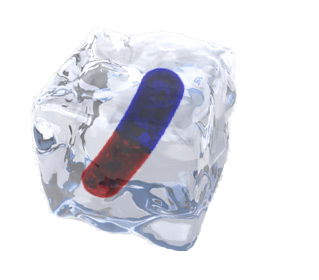Team:Imperial College London/M2/FreezeDrying
From 2009.igem.org
JamesField (Talk | contribs) (→Freeze Drying) |
|||
| (7 intermediate revisions not shown) | |||
| Line 1: | Line 1: | ||
{{Imperial/09/TemplateTop}} | {{Imperial/09/TemplateTop}} | ||
| - | |||
| - | |||
=[[Image:II09_Thumb_m2.png|40px]]<font size='5'><b>Module 2 - Encapsulsation Overview</b></font>= | =[[Image:II09_Thumb_m2.png|40px]]<font size='5'><b>Module 2 - Encapsulsation Overview</b></font>= | ||
[[Image:II09_TimelineM2.png |center| 600px]] | [[Image:II09_TimelineM2.png |center| 600px]] | ||
| Line 7: | Line 5: | ||
[[Image:IceBac2.png|left|250px]] | [[Image:IceBac2.png|left|250px]] | ||
| - | + | An important consideration when designing the E.ncapsulator was the ability to store the cells for extended periods of time. While biological material can be stored for extended periods of time by dehydration, under such conditions the integrety of both a cell's membrane and intracellular polypeptides can be compromised. | |
| - | Trehalose is a disaccharide formed from two glucose molecules | + | In order to preserve the integrity of our protein of interest during storage of the E.ncapsulator, we decided to incorporate a device for trehalose production within our system. Trehalose is a disaccharide formed from two glucose molecules. Throughout nature, trehalose is associated with resistance to dessication and cold shock, and is naturally produced in E.coli. We hope that by upregulating the trehalose production pathways in E.coli we can increase trehalose concentrations within our cell, thereby conferring some resistance to protein degredation in our system. |
| - | |||
| - | |||
| - | |||
| - | |||
| - | |||
| - | |||
| - | |||
| - | |||
{{Imperial/09/Division}} | {{Imperial/09/Division}} | ||
| - | <center> | + | <center> |
| + | ===Module 2 : Freeze Drying=== | ||
| + | </center> | ||
| - | <html><center><a href="https://2009.igem.org/Team:Imperial_College_London/M2"><img style="vertical-align:bottom;" width="20%" src="http://i691.photobucket.com/albums/vv271/dk806/II09_Homepageimage3.png"></a><a href="https://2009.igem.org/Team:Imperial_College_London/M2/EncapsulationRationale"><img style="vertical-align:bottom;" width="20%" src="http://i691.photobucket.com/albums/vv271/dk806/ | + | <html><center><a href="https://2009.igem.org/Team:Imperial_College_London/M2"><img style="vertical-align:bottom;" width="20%" src="http://i691.photobucket.com/albums/vv271/dk806/II09_Homepageimage3.png"></a><a href="https://2009.igem.org/Team:Imperial_College_London/M2/EncapsulationRationale"><img style="vertical-align:bottom;" width="20%" src="http://i691.photobucket.com/albums/vv271/dk806/II09_acidprotection.png"></a><a |
| - | href="https://2009.igem.org/Team:Imperial_College_London/M2/Genetic"><img style="vertical-align:bottom;" width="20%" src="http://i691.photobucket.com/albums/vv271/dk806/ | + | href="https://2009.igem.org/Team:Imperial_College_London/M2/Genetic"><img style="vertical-align:bottom;" width="20%" src="http://i691.photobucket.com/albums/vv271/dk806/II09_geneticcircuit1.png"></a><a |
| - | href="https://2009.igem.org/Team:Imperial_College_London/M2/Wetlab"><img style="vertical-align:bottom;" width="20%" src="http://i691.photobucket.com/albums/vv271/dk806/ | + | href="https://2009.igem.org/Team:Imperial_College_London/M2/Wetlab"><img style="vertical-align:bottom;" width="20%" src="http://i691.photobucket.com/albums/vv271/dk806/II09_Wetlabmainimage9.png"></a><html><a |
| - | href="https://2009.igem.org/Team:Imperial_College_London/M2/Modelling"><img style="vertical-align:bottom;" width="20%" src="http://i691.photobucket.com/albums/vv271/dk806/ | + | href="https://2009.igem.org/Team:Imperial_College_London/M2/Modelling"><img style="vertical-align:bottom;" width="20%" src="http://i691.photobucket.com/albums/vv271/dk806/II09_Drylabmainimage6.png"></a><center></html> |
| Line 46: | Line 38: | ||
<td width="1%"></td> | <td width="1%"></td> | ||
</tr></table></html> | </tr></table></html> | ||
| + | |||
| + | <html><center><a href="https://2009.igem.org/Team:Imperial_College_London/M2#Module_2_Contents"><img width=150px src="https://static.igem.org/mediawiki/2009/1/10/II09_TourArrow.png"></a> | ||
| + | </html> | ||
| + | |||
{{Imperial/09/TemplateBottom}} | {{Imperial/09/TemplateBottom}} | ||
Latest revision as of 13:40, 17 October 2009

 Module 2 - Encapsulsation Overview
Module 2 - Encapsulsation Overview
Freeze Drying
An important consideration when designing the E.ncapsulator was the ability to store the cells for extended periods of time. While biological material can be stored for extended periods of time by dehydration, under such conditions the integrety of both a cell's membrane and intracellular polypeptides can be compromised.
In order to preserve the integrity of our protein of interest during storage of the E.ncapsulator, we decided to incorporate a device for trehalose production within our system. Trehalose is a disaccharide formed from two glucose molecules. Throughout nature, trehalose is associated with resistance to dessication and cold shock, and is naturally produced in E.coli. We hope that by upregulating the trehalose production pathways in E.coli we can increase trehalose concentrations within our cell, thereby conferring some resistance to protein degredation in our system.
Module 2 : Freeze Drying






 "
"





